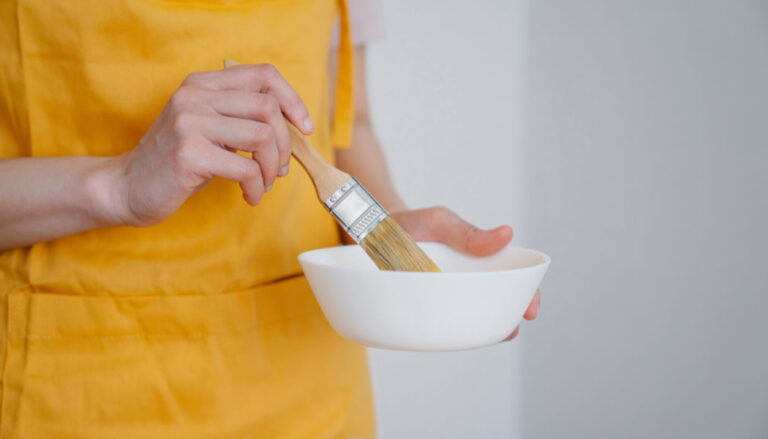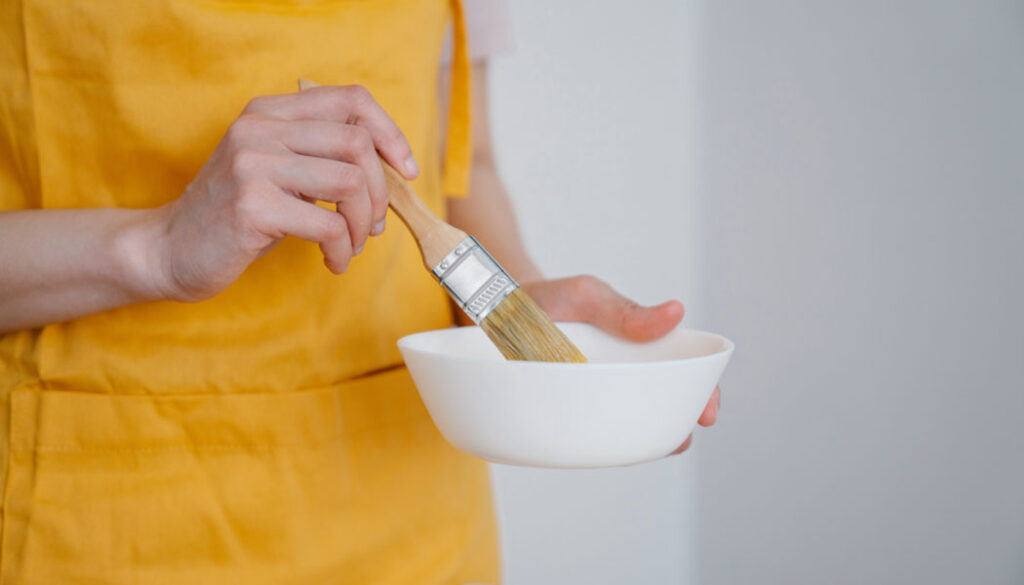
Can You Mix Glitter with Acrylic Paint? [A Beginner’s Guide]
Whether you’re an aspiring artist or someone who loves to dabble in crafts, adding a touch of shine to your creations can elevate them to a whole new level. One popular way to achieve this dazzling effect is by incorporating glitter into your artwork. But can you mix glitter with acrylic paint?
You can mix glitter particles with acrylic paint. The result will be something that will wholly change your decorative works.

In this guide, we will explore the exciting possibilities of mixing glitter with acrylic paint. We will delve into the techniques, tips, and considerations that will help you navigate this glittery journey.
Glitter and Acrylic Paint: Characteristics and Uses
Glitter and acrylic paint are popular materials in the world of crafts and artistic expression. Glitter adds a touch of sheen, while acrylic paint offers versatility and vibrant colors. Let’s explore their characteristics and uses briefly.
Glitter
Glitter refers to tiny, reflective particles that come in various colors. They are typically made from materials such as plastic, glass, or metal. They are often used to add glaze to various objects or surfaces. Glitter can come in different forms, including loose particles, adhesive-backed sheets, or mixed with other substances like paint or glue.
Glitter particles have a reflective surface that catches and reflects light, creating a sparkling effect. They are typically very small, ranging from a fraction of a millimeter to a few millimeters in size. These are available in a wide range of colors, allowing for versatile decorative options.
Glitter can be applied to various surfaces such as paper, fabric, wood, or plastic. It is often used to enhance the appearance of decorations for events, parties, or festive occasions. It can be mixed with paint, glue, or other mediums to create unique textures and visual effects in paintings, sculptures, or mixed media artwork.
Acrylic Paint
Acrylic paint refers to a fast-drying, water-based paint that contains pigment suspended in an acrylic polymer emulsion. It is known for its versatility, durability, and ease of use. Acrylic paint can be used on various surfaces and provides a wide range of finishes, from matte to glossy.
Acrylic paint dries quickly compared to other paint types, allowing for rapid layering and overpainting. It is water-based, making it easy to clean up with water and soap. It can also be thinned or diluted with water for different effects.
This paint can be used on a wide range of surfaces, including canvas, wood, paper, fabric, ceramics, and more. It has good coverage and can often provide opaque or semi-opaque layers, depending on the pigment concentration.
Acrylic paints can be easily mixed together to create a vast array of colors and shades. They can also be mixed with various mediums to alter their properties.
Can You Mix Glitter with Acrylic Paint?
Yes, you can mix glitter with acrylic paint to add sparkle and texture to your decorative works. Mixing glitter with acrylic paint can create a dazzling effect, especially when the light catches the glitter particles. It can be used to enhance various art projects, such as paintings, crafts, and DIY decorations.
When mixing glitter with acrylic paint, ensure that the glitter particles are fine and compatible with the paint. Chunky glitters may not mix well and could affect the consistency of the paint. It is recommended to use fine glitter or glitter specifically made for mixing with paint.
One advantage of mixing glitter with acrylic paint is the ability to create unique and eye-catching textures. The glitter particles can give your artwork a three-dimensional aspect, adding depth and visual interest. This can be particularly appealing when creating abstract or decorative pieces.
However, there are a few things to keep in mind when mixing glitter with acrylic paint. The presence of glitter can affect the drying time of the paint, so it’s important to allow sufficient drying time. Moreover, if you plan to varnish or seal your artwork, be aware that some varnishes may dull the glitter effect.
How to Mix Glitter with Acrylic Paint: Step-by-Step
Mixing glitter with acrylic paint is a wise decision when you want to add a beautiful shimmer to your work. Check this guide on how to do it.
Materials You Need:
- Acrylic paint (any color of your choice)
- Fine glitter (choose a color that complements your paint)
- Mixing palette or disposable plate
- Mixing utensil (such as a palette knife or plastic spoon)
- Paintbrushes
- Canvas or painting surface
- Protective covering for your workspace (optional)
- Clear varnish or sealant (optional)
Step 1: Prepare your workspace
Cover your workspace with a protective covering like newspaper or plastic. This will help to avoid any accidental spills or stains.
Step 2: Squeeze out acrylic paint
Squeeze out the desired amount of acrylic paint onto your mixing palette or a disposable plate. You can choose any color you like, depending on your artistic vision.
Step 3: Add glitter to the paint
Sprinkle a small amount of fine glitter onto the paint. Start with a conservative amount and gradually add more if desired. You can always add more glitter later if needed.
Step 4: Mix the paint and glitter
Use a palette knife or plastic spoon to thoroughly mix the glitter into the acrylic paint. Make sure the glitter is evenly distributed throughout the paint. Continue mixing until you achieve the desired consistency.
Step 5: Test the mixture
Before applying the glitter paint to your artwork, it’s good to test the mixture on a small section or scrap paper. This will allow you to see how the glitter appears in the paint and adjust the amount of glitter if necessary.
Step 6: Apply the glitter paint
Once you are satisfied with the glitter paint mixture, use a paintbrush to apply it to your painting surface. You can use various techniques like brush strokes or stippling onto the surface for different effects.
Step 7: Let it dry and evaluate
Allow the paint to dry completely according to the instructions. Once dry, evaluate the glitter effect on your work. If you feel it needs more sparkle, you can repeat the process by applying additional layers of glitter paint.
Step 8: Seal the artwork
To protect the glitter and add a glossy finish, you can apply a sealant over the dried paint. Follow the instructions on the varnish or sealant product for the best results.
Additional Tips
- Use fine glitter for a more subtle shimmer. Go for chunkier glitters if you want a bolder effect.
- If you want a more intense glitter appearance, you can mix the glitter directly into the paint tube before squeezing it onto the palette.
- Keep in mind that excessive mixing can cause the glitter particles to break down or lose their sparkle. So, try to minimize excessive manipulation.
- Clean your brushes and utensils thoroughly with water immediately after use. This will prevent the glitter from clumping or hardening on them.
What Happens if You Mix Glitter with Acrylic Paint?
When you mix glitter with acrylic paint, the following effects typically occur.
Distribution: The glitter particles become evenly dispersed throughout the acrylic paint. Finally, it creates a glittery effect. The paint essentially acts as a medium to hold and distribute the glitter particles.
Aesthetic Enhancement: Glitter adds a sparkling and reflective quality to the paint, giving it a shimmering appearance. The type, size, and color of the glitter used will determine the specific glittering effect produced.
Texture: Glitter particles are often solid and can add texture to the paint. The surface of the dried paint may feel slightly rough or gritty due to the presence of the glitter particles. The texture can vary depending on the size and amount of glitter added.
Light Reflection: Glitter particles reflect light, enhancing the overall reflective properties of the acrylic paint.
Note: It’s significant to note that glitter does not chemically react with acrylic paint. Instead, it is simply suspended within the paint as an additive. The glitter particles will remain intact and separate from the paint binder, maintaining their original properties.
Is It Safe to Use Glitter with Acrylic?
Using glitter with acrylic can be safe as long as you take certain precautions and use appropriate products. Important considerations to keep in mind –
Use cosmetic-grade glitter: When working with glitter, make sure to use glitter that is specifically labeled as “cosmetic-grade” or “body-safe.” These glitters are less likely to cause irritation or allergic reactions.
Avoid non-cosmetic glitters: Non-cosmetic glitters, such as craft glitters might have sharp edges or contain chemicals that could cause irritation.
Mix glitter with acrylic gel: To incorporate glitter into acrylic, it’s recommended to mix it with an acrylic gel or medium. This helps to bind the glitter particles and prevent them from coming loose during application or over time.
Be cautious around the eyes: Glitter particles can be irritating if they get into your eyes. When using glitter near the eye area, exercise caution to prevent it from falling into your eyes. If you wear contact lenses, it’s best to remove them before applying glitter.
Always prioritize safety and choose high-quality, skin-safe products when working with glitter and acrylic. If you have any concerns or experience any adverse reactions, consult a medical professional.
Does Glitter Make Acrylic Paint Bad?
No, glitter does not make acrylic paint bad. It can be used to enhance the beauty to your work. However, there are some considerations to keep in mind. You should ensure thorough mixing, using dedicated brushes, using high-quality glitter, and sealing the finished painting.
If you follow these properly, glitter will make acrylic much better for your artwork.
Final Thoughts
You can mix glitter with acrylic paint to add luster to your artwork. Experiment with different types and sizes of glitter to achieve your desired effect. Add glitter gradually to avoid a lumpy texture.
Note that glitter can affect drying time and finish, and may settle at the bottom over time. Choose high-quality, lightfast glitters for long-lasting results. Overall, mixing glitter with acrylic paint can be a fun way to create eye-catching artwork.
